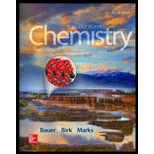
(a)
Interpretation:
The balanced nuclear reaction for the given nuclear reaction is to be determined
(a)
Explanation of Solution
A nuclear reaction involves changes at the subatomic level such as, the changes in the number of protons, the number of neutrons, and the energy state. To balance a nuclear reaction, two conservation conditions can be used, conservation of mass number and conservation of charges (atomic number).
The given reaction is as follows.
Where,
Apply the conservation conditions for mass numbers and
The sum of mass numbers of reactants is equal to the sum of mass numbers of the products.
Similarly, balance the atomic numbers. The sum of atomic numbers of reactants is equal to the sum of atomic numbers of the products.
The element with atomic number
(b)
Interpretation:
The balanced nuclear reaction for the given nuclear reaction is to be determined
(b)
Explanation of Solution
The given reaction is as follows.
Where,
Apply the conservation conditions for mass numbers and atomic numbers to identify the product,
Similarly, balance the atomic numbers. The sum of atomic numbers of reactants is equal to the sum of atomic numbers of the products.
As the charge is
Hence, the balanced reaction can be written as,
(c)
Interpretation:
The balanced nuclear reaction for the given nuclear reaction is to be determined
(c)
Explanation of Solution
The given reaction is as follows.
Where,
Apply the conservation conditions for mass numbers and atomic numbers to identify the product,
Balance the mass numbers.
The sum of mass numbers of reactants is equal to the sum of mass numbers of the products.
Similarly, balance the atomic numbers. The sum of atomic numbers of reactants is equal to the sum of atomic numbers of the products.
The element with atomic number
Hence, the balanced reaction can be written as,
(d)
Interpretation:
The balanced nuclear reaction for the given nuclear reaction is to be determined
(d)
Explanation of Solution
The given reaction is as follows.
Where,
Apply the conservation conditions for mass numbers and atomic numbers to identify the product,
Balance the mass numbers. The sum of mass numbers of reactants equal to the sum of mass numbers of the products.
Similarly, balance the atomic numbers.
The sum of atomic numbers of reactants is equal to the sum of atomic numbers of the products.
The element with atomic number
Want to see more full solutions like this?
Chapter 15 Solutions
Introduction to Chemistry
- Calculate the pH and the pOH of each of the following solutions at 25 °C for which the substances ionize completely: (a) 0.000259 M HClO4arrow_forwardWhat is the pH of a 1.0 L buffer made with 0.300 mol of HF (Ka = 6.8 × 10⁻⁴) and 0.200 mol of NaF to which 0.160 mol of NaOH were added?arrow_forwardDetermine if the following salt is neutral, acidic or basic. If acidic or basic, write the appropriate equilibrium equation for the acid or base that exists when the salt is dissolved in aqueous solution. If neutral, simply write only NR. Be sure to include the proper phases for all species within the reaction. NaN₃arrow_forward
- A. Draw the structure of each of the following alcohols. Then draw and name the product you would expect to produce by the oxidation of each. a. 4-Methyl-2-heptanol b. 3,4-Dimethyl-1-pentanol c. 4-Ethyl-2-heptanol d. 5,7-Dichloro-3-heptanolarrow_forwardWhat is the pH of a 1.0 L buffer made with 0.300 mol of HF (Ka = 6.8 × 10⁻⁴) and 0.200 mol of NaF to which 0.160 mol of NaOH were added?arrow_forwardCan I please get help with this.arrow_forward
- Determine if the following salt is neutral, acidic or basic. If acidic or basic, write the appropriate equilibrium equation for the acid or base that exists when the salt is dissolved in aqueous solution. If neutral, simply write only NR. Be sure to include the proper phases for all species within the reaction. N₂H₅ClO₄arrow_forwardPlease help me with identifying these.arrow_forwardCan I please get help with this?arrow_forward
 Introduction to General, Organic and BiochemistryChemistryISBN:9781285869759Author:Frederick A. Bettelheim, William H. Brown, Mary K. Campbell, Shawn O. Farrell, Omar TorresPublisher:Cengage Learning
Introduction to General, Organic and BiochemistryChemistryISBN:9781285869759Author:Frederick A. Bettelheim, William H. Brown, Mary K. Campbell, Shawn O. Farrell, Omar TorresPublisher:Cengage Learning Chemistry: Principles and PracticeChemistryISBN:9780534420123Author:Daniel L. Reger, Scott R. Goode, David W. Ball, Edward MercerPublisher:Cengage Learning
Chemistry: Principles and PracticeChemistryISBN:9780534420123Author:Daniel L. Reger, Scott R. Goode, David W. Ball, Edward MercerPublisher:Cengage Learning General, Organic, and Biological ChemistryChemistryISBN:9781285853918Author:H. Stephen StokerPublisher:Cengage Learning
General, Organic, and Biological ChemistryChemistryISBN:9781285853918Author:H. Stephen StokerPublisher:Cengage Learning Chemistry: The Molecular ScienceChemistryISBN:9781285199047Author:John W. Moore, Conrad L. StanitskiPublisher:Cengage Learning
Chemistry: The Molecular ScienceChemistryISBN:9781285199047Author:John W. Moore, Conrad L. StanitskiPublisher:Cengage Learning General Chemistry - Standalone book (MindTap Cour...ChemistryISBN:9781305580343Author:Steven D. Gammon, Ebbing, Darrell Ebbing, Steven D., Darrell; Gammon, Darrell Ebbing; Steven D. Gammon, Darrell D.; Gammon, Ebbing; Steven D. Gammon; DarrellPublisher:Cengage Learning
General Chemistry - Standalone book (MindTap Cour...ChemistryISBN:9781305580343Author:Steven D. Gammon, Ebbing, Darrell Ebbing, Steven D., Darrell; Gammon, Darrell Ebbing; Steven D. Gammon, Darrell D.; Gammon, Ebbing; Steven D. Gammon; DarrellPublisher:Cengage Learning Chemistry & Chemical ReactivityChemistryISBN:9781337399074Author:John C. Kotz, Paul M. Treichel, John Townsend, David TreichelPublisher:Cengage Learning
Chemistry & Chemical ReactivityChemistryISBN:9781337399074Author:John C. Kotz, Paul M. Treichel, John Townsend, David TreichelPublisher:Cengage Learning





